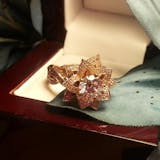Well, the truth is, it wasn’t invented per se.
Cubic zirconia is a naturally occurring substance. Some place its discovery as far back as 1892, with the discovery of naturally occurring zirconium oxide, or baddeleyite. But that’s a long way from your shiny cubic zirconia engagement ring! The natural form of cubic zirconia (or CZ, as it is popularly known) is so rare, that you can assume the CZ you find in any piece of jewelry has been synthesized.
It was a long research road from naturally occurring CZ to the jewelry store, and to your love story, in the form of jewelry.
In 1937, German mineralogists noted its presence as a byproduct of an unrelated experiment. They didn’t even bother to give it a name. Early research sought uses for laser technology and other optical applications.
No one bothered about CZ’s amazing bling potential.
CZ carried on in relative anonymity until Soviet scientists discovered how to grow CZ crystals in a lab.
Cubic Zirconia melts at such high temperatures that no metal can serve as its container. Soviets discovered the method of using a skull crucible, which is a super-cool name, and which allowed the CZ to grow successfully.
Oh, those Russians! Their research was not published until 1973 (perhaps something to do with an unfortunate business called the Cold War?).


By 1976, commercial production began world-wide. Cubic Zirconia has graduated from obscurity to becoming the most important competitor of the diamond industry.
Tekla Luchenski
Staff Writer











